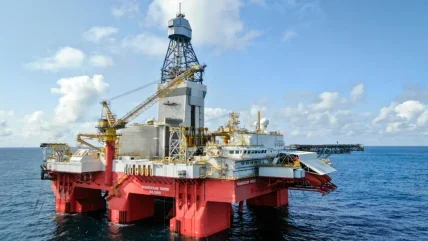
Wintershall Dea has made a gas, condensate, and oil discovery in production licence 248 (PL 248) in the Norwegian North Sea through the drilling of the exploratory well 35/11-27 S.
Dubbed as Cuvette, the discovery is located 100km southwest of Florø.
Wintershall Dea is the operator of PL 248 with a stake of 60%. The German firm is partnered with Norwegian state-owned company Petoro, which holds the remaining 40% stake.
Located 3km south of the Wintershall Dea Norge-operated Vega field, the Cuvette well was drilled by the Transocean Norge rig to a depth of 3,986m below sea level.
The exploration in PL 248 yielded discoveries across four different formations.
Preliminary estimates indicate recoverable volumes between 1.5-3.5 million standard cubic metres of oil equivalent (Sm3 o.e.) in the Tarbert and Upper Ness formations, corresponding to 9-22 million barrels of oil equivalent.
Additionally, the Upper Jurassic formation is estimated to hold between 1.1-2.6 million Sm3 o.e., equivalent to 7-16 million barrels of oil.
With a water depth of 378m at the site, the licensees are evaluating plans to connect the Cuvette discovery to existing infrastructure in the area. The licensees will now permanently plug and abandon the 35/11-27 S well.
During drilling, the 35/11-27 S well encountered an additional interval in the Upper Jurassic and identified an oil zone in the Etive Formation, although specific volume estimates for the latter are pending.
The primary aim of the drilling was to confirm petroleum presence in Middle Jurassic reservoir rocks, with a secondary objective to identify petroleum in Upper Jurassic sandstones.
The well intersected a gas/condensate column spanning 55m in the Tarbert and Upper Ness formations, with a substantial portion exhibiting moderate to poor reservoir quality. No gas/water contact was found in this section.
In the Middle Jurassic Etive Formation, a 5m oil column was discovered, primarily composed of sandstones of poor to moderate reservoir quality. However, an oil/water contact was encountered at 3,843m below sea level.
Exploration in the Upper Jurassic revealed two petroleum-bearing intervals. The uppermost interval contained an 8m gas/condensate column, predominantly in sandstones with poor reservoir properties and no gas/water contact.
The lowermost interval contained a 16m gas/condensate column, with 14m in sandstones of poor to moderate reservoir quality and a hydrocarbon/water contact at 3,327m below sea level.
Although the well was not formation-tested, extensive data acquisition and sampling were conducted throughout the drilling operation.






